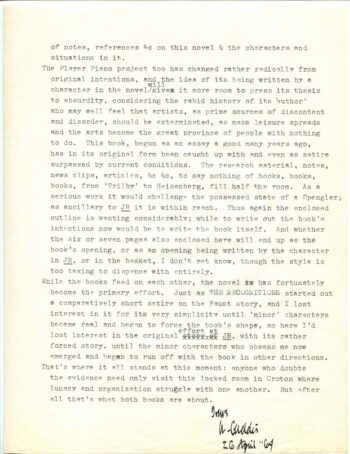
“Lunacy and Organization” in the William Gaddis Papers, Part 1
In celebration of the new editions of William Gaddis’s first two novels, The Recognitions and J R, both published by NYRB Classics, we are exploring the origins of the books in the William Gaddis Papers.

On April 26, 1964, William Gaddis wrote a letter to his literary agent, Candida Donadio, explaining the expansion of his second novel, J R, and comparing it to a similar evolution that happened with his first, The Recognitions, published nine years prior. In both cases, the author began to lose interest in the core plotline “until the minor characters who obsess me now emerged and began to run off with the book in other directions.”

Gaddis then closed the letter, which accompanied a five-page summation of the novel-in-progress, by writing, “…anyone who doubts the evidence need only visit this locked room in Croton where lunacy and organization struggle with one another. But after all that’s what both books are about.”

Reading this letter again made me think not only of the two books, but of the papers Gaddis generated writing them. Though the papers moved to acid-free folders and boxes after Washington University acquired them 2001, the “lunacy and organization” of them has remained largely intact. Many Gaddis scholars have visited our reading room to pore over the files and discover for themselves what the author kept and how he kept them–clues to why and how the books came together as they did.

As with reading the books, it takes uninterrupted time, focus, and patience to explore the boxes of raw materials Gaddis kept as he wrote these landmarks of 20th century fiction while living his life–first as an international traveler expelled from Harvard doing manual labor on a limited budget, and then as a writer for corporations and a family man settled down on Long Island.

One of those aforementioned Gaddis scholars is Joseph Tabbi. He said it best in his illuminative 2015 book, Nobody Grew but the Business: On the Life and Work of William Gaddis.
“We might begin to understand, through Melville, why Gaddis–who was otherwise so selective in what he shared with interviewers–took care to preserve and make available to posterity so many of the materials that went into the books. The clippings and rejected drafts and even the notes toward anonymous corporate writings are all there in the archive, evidence of all that passed before the self that mattered most to Gaddis at the moment of composition. In this sense, through his own impulse toward preservation, we have a kind of access to the ‘larger book’ that remained on Gaddis’s own ‘private shelf.’” (p. 102)

One of the principles in archival theory is original order—maintaining the record creator’s organizational methods as it goes from its primary use to becoming an accessible collection for research. In short, the original order is an important part of understanding the creator and their finished creations, and William Gaddis and his groundbreaking novels are no exception to this rule.

At the same time, curators and archivists do play an important role in making collections more accessible by imposing at least a minimal amount of order to the physical arrangement, not to mention by creating finding aids, exhibits, blog posts, and publications, so a researcher knows what to expect, where to start, and how much time to spend with the collection.

With all that in mind, and to help celebrate the new editions of The Recognitions and J R, I decided to take a deeper dive into the papers toward both books, providing more samples of the types of materials found therein. Part 2 of this series will focus on J R, which represents over 28 boxes in the William Gaddis Papers. That blog post will be followed by Part 3, on the papers toward The Recognitions.
In the meantime, take a look at what we have on both books and beyond on the Gaddis pages of MLC50. Enjoy, and stay tuned!
